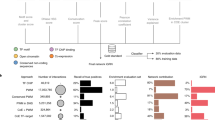Abstract
Elucidation of gene regulatory networks is the key to understanding the complex interplay of transcription factors (TFs) in the growth and propagation of organisms. In this work, we applied the theory that genes belonging to the same pathway are co-expressed, and therefore a promoter analysis of Arabidopsis genes could predict the transcriptional relationships between metabolic pathway genes. Using this approach, a total of 2268 TF-gene pairs were analyzed, 91 of which were characterized as highly confident, and 4 were confirmed by previously published experimental data. These results suggest that the predictions by this model are reliable. Furthermore, we demonstrated that the use of metabolic pathways to interpret gene regulatory networks of Arabidopsis has the potential to improve our understanding of the role of these processes in plant development and to identify biological functions of unknown genes.
Similar content being viewed by others
References
Matthews L, Gopinath G, Gillespie M, ea at. Reactome knowledgebase of human biological pathways and processes. Nucleic Acids Res, 2009, 37(Database issue): D619–D622
Kanehisa M, Araki M, Goto S, et al. KEGG for linking genomes to life and the environment. Nucleic Acids Res, 2008, 36(Database issue): D480–D484
Caspi R, Foerster H, Fulcher C A, et al. The MetaCyc Database of metabolic pathways and enzymes and the BioCyc collection of Pathway/Genome Databases. Nucleic Acids Res, 2008, 36(Database issue): D623–D631
Krull M, Pistor S, Voss N, et al. TRANSPATH: An information resource for storing and visualizing signaling pathways and their pathological aberrations. Nucleic Acids Res, 2006, 34(Database issue): D546–D551
Swarbreck D, Wilks C, Lamesch P, et al. The Arabidopsis Information Resource (TAIR): Gene structure and function annotation. Nucleic Acids Res, 2007: 1–6
Jong H D. Modeling and simulation of genetic regulatory systems:a literature review. J Comput Biol, 2002, 9: 67–103
Espinosa-Soto C, Padilla-Longoria P, Alvarez-Buylla E R. A gene regulatory network model for cell-fate determination during Arabidopsis thaliana flower development that is robust and recovers experimental gene expression profiles. Plant Cell, 2004, 16: 2923–2939
Keurentjes J J B, Fu J, Terpstra I R, et al. Regulatory network construction in Arabidopsis by using genome-wide gene expression quantitative trait loci. Proc Natl Acad Sci USA, 2007, 104: 1708–1713
Lackner D H, Beilharz T H, Marguerat S, et al. A network of multiple regulatory layers shapes gene expression in fission yeast. Mol Cell, 2007, 26: 145–155
McAdams H H, Shapiro L. A bacterial cell-cycle regulatory network operating in time and space. Science, 2003, 301: 1874–1877
Mathur D, Danford T W, Boyer L A, et al. Analysis of the mouse embryonic stem cell regulatory networks obtained by ChIP-chip and ChIP-PET. Genome Biology, 2008, 9: R126
Tsai H K, Lu H H, Li W H. Statistical methods for identifying yeast cell cycle transcription factors. Proc Natl Acad Sci USA, 2005, 102: 13532–13537
Wei H, Persson S, Mehta T, et al. Transcriptional coordination of the metabolic network in Arabidopsis. Plant Physiol, 2006, 142: 762–774
Srinivasasainagendra V, Page G P, Mehta T, et al. CressExpress: A tool for large-scale mining of expression data from Arabidopsis. Plant Physiol, 2008, 147: 1004–1016
Obayashi T, Hayashi S, Saeki M, et al. ATTED-II provides coexpressed gene networks for Arabidopsis. Nucleic Acids Res, 2009, 37(Database issue): D987–D991
Bailey T L, Williams N, Misleh C, et al. MEME: Discovering and analyzing DNA and protein sequence motifs. Nucleic Acids Res, 2006, 34(Web Server issue): W369–W373
Caselle M, Di Cunto F, Provero P. Correlating overrepresented upstream motifs to gene expression: A computational approach to regulatory element discovery in eukaryotes. BMC Bioinformatics 2002, 3: 7
Mahony S, Benos P V. STAMP: A web tool for exploring DNA-binding motif imilarities. Nucleic Acids Res, 2007, 35(Web Sever issue):W253–W258
Matys V, Fricke E, Geffers R, et al. TRANSFAC: Transcriptional regulation, from patterns to profiles. Nucleic Acids Res, 2003, 31: 374–378
Steffens N O, Galuschka C, Schindler M, et al. AthaMap: an online resource for in sillico transcription factor binding sites in the Arabidopsis thaliana genome. Nucleic Acids Res, 2004, 32(Database issue): D368–D372
Palaniswamy S K, James S, Sun H. AGRIS and AtRegNet. A platform to link cis-regulatory elements and transcription factors into regulatory networks. Plant Physiol, 2006, 140: 818–829
Huang J F, Yang J J, Wang G, et al. Prediction of anther-expressed gene regulation in Arabidopsis. Chinese Sci Bull, 2008, 53: 3198–3203
Vandepoele K, Vlieghe K, Florquin K, et al. Genome-wide identification of potential plant E2F target genes. Plant Physiol, 2005, 139: 316–328
Gao Y, Li J, Strickland E, et al. An Arabidopsis promoter microarray and its initial usage in the identification of HY5 binding targets in vitro. Plant Mol Biol, 2004, 54: 683–699
Author information
Authors and Affiliations
Corresponding author
Additional information
This work was supported by the Science Foundation of Shanghai Municipal Education Commission (Grant No. 07ZZ60).
About this article
Cite this article
Jiao, Q., Yang, Z. & Huang, J. Construction of a gene regulatory network for Arabidopsis based on metabolic pathway data. Chin. Sci. Bull. 55, 158–162 (2010). https://doi.org/10.1007/s11434-009-0728-8
Received:
Accepted:
Published:
Issue Date:
DOI: https://doi.org/10.1007/s11434-009-0728-8




